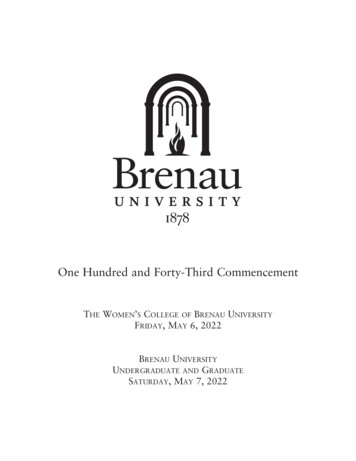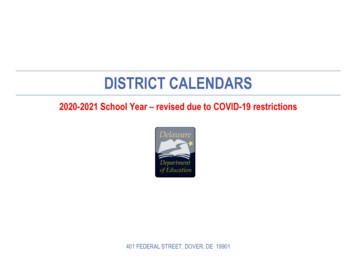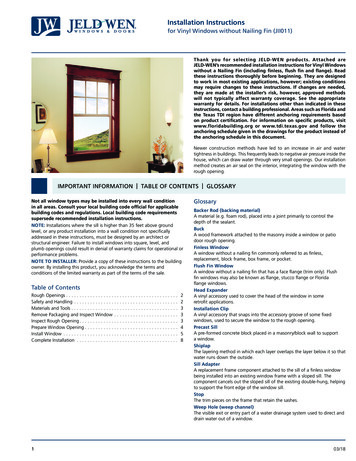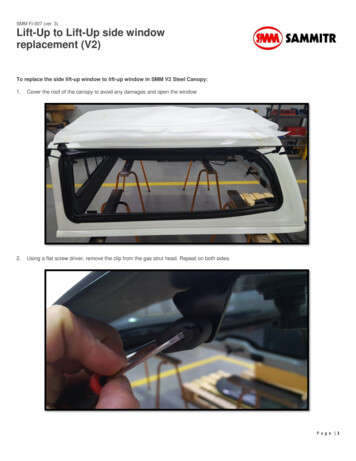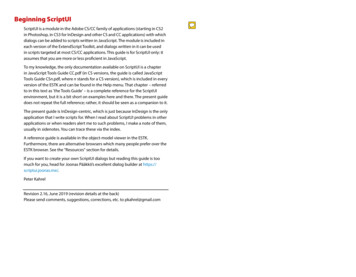
Transcription
Winter 2009aStudying and PracticingGoodbye, Mr. BoothSustainabilityOT’s Fabulous Decade
president’s MESSAGETHE CAPACITY TO ENDUREBRENAU WINDOW WINTER 2009I2n the late 1960s, the world witnessed something phenomenal, the emergence of a grass-roots initiative toincrease global awareness of the ecological problems ofthe earth and man’s role in both creating and solving thoseproblems. It was a movement primarily of young people,mostly college and university students, concerned scientists,a handful of political leaders and the usually quiet and laidback folk of the nature-loving set. Their heroes were GaylordNelson and Morris Udall, Jacques Cousteau, Roger Revelle,John Muir, Jane Goodall and Rachel Carson. On April 22,1970, they pulled off something that even John F. Kennedyhad failed to accomplish. That day they mobilized some 20million Americans, a tenth of the population, to participatein what was the irst Earth Day, which became the pivotalevent in the modern environmental movement. Its agendawas nothing more that promoting a healthy, sustainable environment on the planet.President Nixon ignored Earth Day, but by the timehe left ofice he had signed legislation creating the Environmental Protection Agency, the National Oceanic andAtmospheric Administration, the Clean Air Act, the CleanWater Act, the Pesticide Control Act, the Endangered Species Act and the Safe Drinking Water Act. That irst EarthDay gave birth to a generation of Americans and othersaround the world with a native awareness of sustainability.Environmental issues, which President Kennedy could noteven raise a pulse for, now are topics of high-level summitsof world leaders and major considerations of a small towncouncil as it considers whether to permit construction of aWalmart store. One of the major complaints that I have addressed as president of Brenau – from students, faculty andstaff – is why we don’t do more to recycle soft drink cans,water bottles and waste paper.Yet, at some time between then and now, we as asociety somehow lost that initial Earth Day momentum,or at least deviated from it. For one thing, issues related toenvironmental protection and sustainable living often driftinto the minutia and sometimes indecipherable languageof science. Whenever I am on the podium as excited as Ican be talking about successes in dealing with the effects ofchloroluorocarbons on ozone depletion, even the scientistin me tells me not to test too much the audience tolerancefor “ecology-speak.” Also, no matter how much one tries toavoid it, issues of sustainability and environmental concernsalways get tangled in politics, in bureaucratic inighting,international diplomacy and sometimes religion. Sustainability begets initiatives that become quick, easy sacriices on thealtar of public opinion or to audiences of sanctimonious talkshow hosts.Perhaps the major frustration, even those of the environmentally conscious generations of the last 40 years, isthat the problems which were prevalent then are still with ustoday – depletion of the ozone layer that protects the earth,global climate change, ocean pollution and solid waste disposal. And they just sound so downright ominous. What canI possibly do as an 18-year-old college student at Brenau oras a 25-year-old nurse or a 50-year-old real estate salesman toovercome centuries of pollution in our waterways or to stopthe melting of polar ice caps and glaciers? What differencecould it possibly make if, on a busy day, I toss my empty softdrink can into the wastebasket by my desk rather than walkdown the hall to the recycling box?We are pushing awareness of sustainability to the forefront at Brenau because it is the right thing to do, not onlyfor the sustainability of our planet, but also for the sustainability of liberal arts education. Sustainability deines whatinterdisciplinary liberal arts education should be about.During the past semester we have deliberately studied sustainability, the capacity for us to thrive and endure on thisearth, as part of the Brenau curriculum and in extracurricular activities as well. That study will continue.One central message that has emerged is that one person can make a difference. The occupational therapist DianFossey, for example, almost single-handedly saved an animalspecies. And keep in mind that the irst Earth Day individualsfrom all walks of life brought only their personal resources,intellect and moral iber together for a common purpose.Ed Schrader, Ph.D.eschrader@brenau.edu
Administration building at Brenau South Atlanta/Fairburn campus.Author Carmen Deedy pays a surprise visit to the Child Development Center on theGainesville campus and signs books at a public program after a rousing fall convocationaddress: “Timid women don’t leave lasting legacies.”Artist Darryl Pottorf shares with Brenau galleries director Vanessa Grubbs his exceptional perspective on the works of his long-time friend and collaborator, the lateRobert Rauschenberg. Works Pottorf has on loan to the university and pieces in the Brenau permanent collection were included in the Rauschenberg retrospectiveexhibit on campus that included a presentation by Pottorf to a standing-room-only crowd.Recent campuseventsCongolese leader Mwami Alex Kalinda and Pierre Kakule,co-director of the Dian Fossey Gorilla Fund’s programs in theRepublic of Congo, at a Pearce Auditorium symposium.photos by Tom Askew, Louie Favorite and Rudi Kiefer4President Schrader, top, and Fairburn Mayor Betty Hannah atSouth Atlanta regional campus opening.With her irst novel The Help, at No. 3 on The New York Timesbest-seller list, author Kathryn Stockett chats informally with irst-yearstudents before a public reading at Hosch Theater.Dean of Education Lora Bailey, center, hosts nationally recognized experts Douglas H. Clements of theState University of New York in Buffalo and ConstanceKamii of the University of Alabama-Birmingham at asymposium for educators to improve skills for teachingmathematics and sciences to younger pupils.Former Brenau Trustee Lessie Smithgall expressessurprise as the university confers on her a secondhonorary doctorate.Student Shan Zhong of China presents hisbusiness plan for a paper recycling enterpriseat the irst Sustainability Conference.Mary Hart Wilheit chats with author John W. Jacobs Jr. at thelaunch of his book The Longer You Live, published by BrenauUniversity Press.First-year fashion design majorTravee Rose shows her contributionto the Sustainable Fashion Boutique– a dress created from previouslyworn garments and fabrics.WINTER 2009 BRENAU WINDOWBRENAU WINDOW WINTER 2009Bethany Havas, a research and instruction assistant,performs with the Alchemy Drum & Dance Communityof Gainesville at the opening of the Dian Fossey memorabilia exhibit at Trustee Library.One of Dian Fossey’s paintings found inher cottage after she was murdered.5
Brenau experiences recordenrollment in fall term6Scholarships get annualboostStarting with the current fiscal year, all unrestricted annual contributions to Brenau University will be applieddirectly to scholarship funding for deserving students.Currently the university spends about 8 million a yearon direct financial aid, less than 1 million of whichcomes from endowed funds earmarked for scholarships.Brenau makes up the difference with tuition dollars andother regular income.Being Frank BoothA unique new voiceBrenau University has created a publishing arm, Brenau University Press, whichwill support the mission of the universityby making scholarly works and worksof more general interest available tothe global community in a variety offormats. The operation has alreadypublished its first book, the memoriesof Gainesville, Ga., business and civicleader John W. Jacobs, Jr., a Brenau trustee (see backcover for details).Launching the initiative, however, occurred monthsahead of schedule. “A few of us in the administrationwere getting started on the planning for the universitypublishing arm when Mr. Jacobs walked in with his manuscript to get some advice on what to do with it,” says David Morrison, assistant vice president for communicationsand publications. “The book is a great local history and acompelling memoir – exactly the kind of thing universitypresses ought to publish.” Jacobs saw the opportunity,too, and made it possible to launch an enterprise thathad no budget – and to dedicate proceeds from bookssales to Brenau scholarships.Brenau president Ed Schrader kicked off the idea forthe publishing venture earlier this year. It is essential, heargues, that a great university have a means for disseminating scholarly works and other works of significancethat never would attract the attention of commercialpublishers. In coming months the university will developa comprehensive business plan for the self-sustainingpublishing operation.Whenever friends toast Frank Booth as the ultimate “Southern gentleman,”he flushes slightly and ducks his sandy head, as if not to impose.However, because hevalues precision as muchas politeness, Boothwill clear his throat andclarify what that picturesque labelmeans to him: “I believe courtesy andmanners, usually attributed to ‘Southern gentlemen,’ are merely byproductsthat naturally follow attempting tobe honorable.”And honor is not some vague,sepia-toned abstraction to him. Inhis 24 years as headmaster of BrenauAcademy, it proved tensile, necessary,and real as it was tested time and againby giggly pranks; tearful, late-nightemergencies; adolescent rebellionand angst; and other sparks that ly inthe nitroglycerin tinderbox of 70-oddresourceful girls studying and livingtogether under the same roof.“The way people reacted whenthey asked about my work alwaysdepended on their perspective,” saysBooth, who retired as emeritus deanthis fall. “A 20-year-old guy might say,‘You’re in charge of dozens of girls –where do I sign up for that job?’ On theother hand, a parent raising a teenagedaughter or two would say, ‘Bless yourheart, I wouldn’t trade places with youfor anything in the world!’”In fact, it was the boarding school’sunpredictability – the ininite, ramB Y CAN DICE DY E Rbunctious possibility – that kept himentrenched for so long in a role thatcombined elements of “Goodbye, Mr.Chips” with the 1980s sitcom “TheFacts of Life.”“There’s such variety here, suchindividuality and uniqueness of spirit,”Booth says. “There is no such thing as a‘typical Academy girl’ or a ‘normal day.’Just when you think you’ve seen everything, someone does something strangeand amazing.”The son of a kindly town doctorwho occasionally got paid in gardenproduce, Booth grew up with a certainchivalric ethic in Huntington, W. Va.,where he excelled as both a jock and aWINTER 2009 BRENAU WINDOWBRENAU WINDOW WINTER 2009Fueled in part by an onslaught of non-traditional students seeking to bolster job skills or academic credentials in the nation’s dicey employment market, BrenauUniversity posted record enrollments for the 2009-10academic year. In its official October reports to the U.S.Department of Education, Brenau listed overall enrollment at 2,761, which included close to a 15 percentjump in nonresidential campus programs and a morethan 35 percent increase in students seeking graduateand undergraduate degrees online.That falls right in step with Brenau’s strategic plan,which is based on the assumption that the nonresidential programs will experience explosive growth to about4,000, mostly in graduate degree programs, while theresidential Women’s College enrollment will level offat 900 to 1,000 undergraduates. The Women’s Collegeenrolled 891 by the late October cut-off date for thegovernment report; that’s four fewer than enrolled bythe same deadline last year. Nonresidential evening andweekend enrollment, however, jumped from 1,389 to1,451 while online surged to 419 from the 310 reportedat the 2008 reporting deadline.Scott Briell, Brenau senior vice president for enrollment management and student services, concedes theuniversity breathed a sigh of relief because it feared theeconomy would impact residential enrollments more.But by his office’s analysis of new students across theboard the economy definitely was a factor. Growth thisyear came primary from people outside the normal agebracket for college students – those, for example, whomay want to finish the college education they put offearlier in life, who want to improve job skills or switchcareers or those looking for more enrichment in theirintellectual lives.“The Women’s College remains a vital part of theBrenau long-term strategy, but the demographics ofhigher education are changing dramatically year to year,”says Briell. “The university leaders figured that out morethan 30 years ago and began in the 1970s building thefoundation for meeting the needs of the student population we will have in the next two decades.”“Unrestricted means exactly what you might think,”says Matt Thomas, vice president for external relations atBrenau. “Money you gave could be used for anything inthe budget – from salaries to paying the power bill. Butwith this change, we’re restricting it. You will know whenyou contribute to the annual scholarship fund, every dollargoes to scholarships.”The average financial assistance package to afull-time Women’s College student is 15,575 per year,about half the total cost of tuition, fees and room andboard. About 90.6 percent of the students receive somekind of financial assistance through need-based, merit orathletic scholarships.Thomas says another way donors can supportscholarships at Brenau is to investigate if they work forcompanies that match employee contributions to charitable causes. (To find out if your company has a matching gift program, call 770-534-6163.) Whether or notmatching funds are involved, you can make contributionsto the annual scholarship fund on any time schedule youchoose and by any method, including credit card donations. Check www.brenau.edu/giving.7
8student. He would pause between baseball games towait in the back of the synagogue while his Jewishteammate studied for his bar mitzvah. Throughsome process of unwitting linguistic osmosis, Boothcould recite the Hebrew passages he had beenoverhearing. Impressed, the rabbi tapped him toparticipate in his friend’s ceremony, making Boothperhaps the only stalwart Presbyterian to have beenbar mitzvahed, he likes to joke. That experiencehelped foster an enduring interest in language andtheology, as well as a deep appreciation of Yiddishhumor – Booth can regale a dinner party with thebiggest repertoire of Henny Youngman jokes outside the Catskills.Later, this hearth-forged gentility was polished to a gleam at Hampden-Sydney College, oneof the country’s last three all-men’s liberal artsinstitutions, famous for its uncompromising codeof conduct reputedly drafted by Patrick Henry.This decorous utopia in the Wisteria League is arenowned incubator for “Southern gentlemen”coveted by their belle counterparts.“There were no locks on student dorm roomsor classrooms,” Booth remembers wistfully. “Once,taking a Latin quiz in class, my eyes inadvertentlyfell on a classmate’s paper. After class, I went to myprofessor and told him what had happened. Withno concern that I might have been cheating, he toldme he trusted me, praised my honorable action, andgave me a quick substitute question orally; matterresolved. I came to wish idealistically that the wholeworld could be such a place.”It is not, but he strives to make it so.“I have never heard him say an unkind wordto or about anyone, even under extreme duress,”says his former assistant/henchman Charles Burel,who relished his “good cop, bad cop” dynamic withBooth. “And we dealt with all kinds of situations –one student was stuck up in a tree, and we had tocall the ire department.”Recalls Academy alumna Ava Farahany, A ’92,“Dean Booth was a father igure to me throughoutthose years. Mr. Burel was the disciplinarian, likemy mother, and Dean Booth was the one that I feltso guilty getting in trouble for because of his softdemeanor, like my father. He was so kind and gentleeven while being very stern.”His courtliness notwithstanding, Booth, whostudied English and Latin, is lessseersucker than tweed. Explainingwhy he prefers the title “headmaster” to “dean,” he says, “In Old English, ‘master’ means ‘teacher’ – that’swhat teachers are called at Eton.”With this donnish sensibility andimposing height (6’4”), Booth wouldnot look out of place lumbering,Auden-like, amid the swans of Stratford-upon-Avon, where he yearnedto research his graduate thesis on therole of religion in Shakespeare’s life.“He can tell you the Latin derivative of just about any word you throwat him,” marvels Charles Agner, anAcademy math instructor.Believing that sports fosterscharacter development, Booth beefedup the athletic programs, and heestablished traditions to inspire campus spirit: onyx class rings; the irstschool-sponsored reunion; and the“Dean’s Trip,” an education-orientedvacation chaperoned by him andhis wife, Karen, who is an Academyalumna. Booth also developed a inancial aid program and the LearningCenter, and he enrolled the school’sirst African-American student.All of these measures helped diversifyand enrich the student body.“When I irst started at Brenau,many of the students were known“His calm, yet confident demeanor andhis deep understanding of the minds andsouls of the young women who attendBrenau put us all at ease and gave us confidence that we were in the right place,– Chuck Leavelldoing the right thing.”Booth earned a second master’sdegree and a doctorate in education,while working full time as a teacheror administrator, irst at the all-maleKentucky Military Institute, then atAthens Academy, where his dynamicreputation enticed Brenau to comecourting. He assumed leadershiphere during the ascendancy of“day schools.”“About 25 years ago, boardingschools everywhere started closing,or they began taking in large numbersof day students to survive,” Boothsays, noting that the Academy is nowthe only residential girls’ school inGeorgia and one of only a handful inthe country. “It sounds strange to citeour mere existence as an accomplishment, but this has been a dificultclimate for boarding schools.”as ‘bowheads’ wearing lots of pinkand green and aiming for the JuniorLeague,” he says. “Today, you mightsee a pink bow, but behind her will bea girl with pink hair.”The Academy was hip enough,in fact, to attract the daughter of afamous rock star.“When we irst brought ourdaughter up to Brenau to enroll her,like many other parents and childrenin a similar situation, we had mixedfeelings about how it would all turnout,” recalls Chuck Leavell, who hasplayed keyboards for the RollingStones, the Allman Brothers and others. “The irst step was to meet withDean Booth. His calm, yet conidentdemeanor and his deep understanding of the minds and souls of theyoung women who attend Brenau putus all at ease and gave us conidencethat we were in the right place, doingthe right thing. We are grateful beyond words for his wisdom, patienceand talents in educating and guidingour wonderful child, Amy, into thebeautiful person she is.” (See Amy’sstory on page 19.)For her graduation in 1993,Leavell composed and performeda song called “Still My Little Girl.”“Frank, you ROCK!” says thekeyboardist. Booth, touched by thetestimonial, notes with professorialformality that he has always admiredthe Stones, which he called “daringlyiconoclastic and amusingly in-yourface” band.So it seems somehow ittingthat another alumna’s deiningmemory of Booth involves anetiquette lesson: “At our rehearsalfor graduation, we had to practicegoing onstage and shaking his handto get our diploma,” says writer andactress Jodie Milks, A ’89. “I wentup there, slipped a bit on my arrival,and, feeling embarrassed and a littleunder-conident, I kind of fell into aclumsy half-handshake and apologetic taking-of-diploma and skulkedaway. That’s when he pulled me over,in front of everyone, and said, ‘Thisis a great opportunity for all of us tolearn the art of a good handshake.’ ”He then demonstrated a gesturethat was “irm but not bone-crushing,taking into account any enormousrings, involving good eye contact,and exerting a good squeeze beforemoving on. It’s stood me in good stead– I’ve used it in pitch meetings, jobinterviews, buying a car, and I alwaysthink of him fondly,” she says.Booth lives for such moments.“These,” he says, “are the lasting, telling things.”WINTER 2009 BRENAU WINDOWBRENAU WINDOW WINTER 2009Top: At Riverside Military’sannual Superintendent’s Teain 2006, Dr. Booth greetsAcademy student YessikaEneme Lima, A ’08.Center: At a reception withartist Robert Rauschenberg.Below: Charles Burel andDr. Booth during graduation.9
2009–10:team tied No. 17 Auburn University-Montgomery 0-0 indouble overtime. “I just feel like we work harder this yearThe Mo’ Better TigersCross Country: Because the sport doesn’thave as many teams participating in the SSAC, coach Susan McIntyre’s Golden Tigers joined forces with schoolsthat aren’t afiliated with a conference. The Golden Tigersare led by Audra Cochran of Stockbridge, Ga., who rana season-best 21 minutes, 3 seconds to place 56th out of181 runners at the Southeastern Cross Country Classic inLouisville, Ky.10Volleyball:The Golden Tigers’ volleyball teamhas had what Lochstampfor calls “a whole turnaround oftheir program” after being picked in the preseason as theconference doormat. Rebounding from an 8-18 overallrecord and 1-15 in the SSAC last year, coach MeredithMatthews’ squad began 2009 8-0. The Golden Tigersstarted 1-5 in the conference, then came back strongto inish fourth in the eight-team ield. At the AramarkClassic Tournament in Erskine, S.C., seniors KarenGreen of Lawrenceville, Ga., and Audra VanArsdale ofPelham, Ala., were named to the All-Tournament team,with Green also earning MVP honors.Swimming: LucianneSenior forward Lily Futrell sets the pace onsoccer scoring.and we’re a close-knit group,” says forward Lily Futrell ofSavannah, Brenau’s scoring leader. And the league hasnoticed. Goalkeeper Lisa Lesnick of Surfside Beach, S.C.,has been named SSAC Defensive Player of the Week.Tennis: Tennis players Lyn See Choo and KateMazackova continued the Golden Tigers’ tradition ofstrong doubles play by inishing ifth at the InternationalTennis Association NAIA Small College ChampionshipsThe irst winning season for Golden Tigersvolleyball was an impressive 24-11.Soccer: Coming off last year’s 11-6-1 record andthird-place inish in the conference (6-3-1), the GoldenTigers tackled a tough early schedule. After tying theUniversity of Mobile on the road and losing to SpringHill College, Brenau won eight of its next nine matches.The victories included a 2-0 shutout of Lindenwood,then ranked No. 16, and the historic 2-0 win over Berry,soon to be an NCAA Division III school. After a 2-0loss to Shorter snapped a six-game winning streak, theThe No. 10 tennis team last year anticipates stronger playin the spring.in Mobile, Ala. “They foreshadow what will happenin the spring,” Lochstampfor says optimistically. NelliMartyrosyan of Armenia and Liubov Orlova of Russia willKimura and Julia Ferreira of Brazil,Ana Galesic of Croatia and SarahFell of Brunswick, Ga., lead theswim team coached by Gabby Matthews. Mairi Morrison of Scotlandis back after gallbladder surgery.Mairi MorrisonBasketball: With seven seniors, three juniors,three sophomores and ive freshmen, Brenau has depthat every position as it strives for its third straight winning season. Although the Golden Tigers inished ifth inthe SSAC last year with a 17-13 record (10-10 SSAC), theleague’s coaches picked them to place sixth among thenine competing teams. They got off to a good start, posting a 5-2 record by mid-December as the season began.Coach Gary Bays says his team still is considered “thenew kid on the block,” which makes it more dificult forthem to get respect among opponents. But that’s changing rapidly. Hagans, of Snellville, Ga., averaged 21 pointsper game last year and was the program’s irst All-American. She knows she’ll be double- and triple-teamed thisseason. If Hagans can’t get to the ball, players like PaigeCooper of Sarasota, Fla., and Sarah Ledford of Ellijay, Ga.,both all-conference selections, will have to step up in aschedule that includes eight teams that made the 2009NAIA tournament.“My teammates are trying to pressure me more inpractice so I’ll be ready for that when it comes along,”Hagans says. “I’d rather make the conference championship and get that title than have the individual accomplishments. We have a lot to prove, but I think we’regoing to surprise a lot of people this year.”WINTER 2009 BRENAU WINDOWBRENAU WINDOW WINTER 2009B Y KA R E N R OSE NNo Brenau soccer game begins and no practice endswithout the Golden Tigers’ ritual chant.“Will we stop?” shouts senior defender Innis Ette,owner of the loudest voice on the squad. Her teammatesrespond: “No, no, we want some mo‘!”That’s “mo” as in “more,” and this fall the Brenausports teams have forged full speed ahead to provingthemselves to be formidable foes in the newly expanded16-team, two-division Southern States Athletic Conference. The volleyball team had its irst winning seasonsince the program began in 2003, posting a 24-11 recordoverall and 4-7 in conference play. The soccer team began its campaign 8-2-1 with six shutouts – including itsirst win ever over Berry College – and received nationalranking votes. The cross country team inished fourth inan 11-team meet in Marietta.While these sports were winding down, basketballand swimming were gearing up. Four swimmers anda relay team qualiied for NAIA nationals in their irstmeet of the season. The basketball team, competing inonly its fourth year, returns seven seniors, includingAshley Hagans, the NAIA’s leading scorer last season.Brenau athletic director Mike Lochstampfor said ofthe expanded conference, “Clearly it positions us to bemore competitive nationally,” because it will lead tomore challenging conference tournaments, the qualiiersfor national postseason play.return to action after sitting out the fall season becausethey didn’t have enough hours academically. “I think we’llbe stronger than last year,” says coach Gordon Leslie,whose team was ranked No. 10 at the end of the 2008-09season. “We’re looking forward to having a good run inthe national championships.”11
sustainabilityULarry Griffeth14“How many i’s in “sustainability?”a student asked as she made notesduring a lecture. Figuratively, like theword “team,” there should not be any.Sustainability isn’t about “you” or“me,” but those who come after us.The U. S. Environmental ProtectionAgency provides the operative deinitionthese days: Sustainability is “meeting theneeds of the present generation withoutcompromising the ability of futuregenerations to meet their own needs.”By rudi KieFerelected not to shoulder any of the inancial burden. Stategovernment isn’t any more visionary.The governors of the three affected states havefailed to make any headway on resolving the issue. Thatshould not be a surprise: neither did any of their predecessors over at least the last four decades. Now Congressthreatens to jump into the equation, saying that if thestates do not ind a solution soon, it will legislate one.BECOMING PART OF THESOLUTIONWhat does any of this have to do with Brenau University? As long as we are batting about simplistic, clichéddeinitions, the best answer is if you are not part of thesolution, you are part of the problem.“This university has operated in three different centuries,” says Brenau University President Ed Schrader.“In concepts of sustainability and continuity, we’ve had alot of time to think about, and respond to, the changingneeds of society and the environment. The needs of ournatural environment may not have changed very much,but human activity is seen in much sharper focus todaythan it was just a few decades ago. We need to have it onour academic agenda every day, not at time intervals.”What does that mean in practical terms? “BrenauUniversity can’t go out there and clean up a toxic spill, orprevent global climates from changing, or prevent deforestation in the Amazon,” Schrader explains. “But we canproduce the golden bullet that is equipped to tackle suchtasks: Brenau graduates. The answer lies in educatingour students in such a way that they can step out intothe world ready to take responsible action.”To that end Schrader earlier this year commissioneda Brenau “sustainability initiative,” envisioned to bringthe university’s academic programs and operational practices more fully into the commonweal of meeting today’sneeds without compromising the future. He drafted Dr.Maria Zayas, a psychology professor, to head a task forcefrom across all aspects of the university to, as she put it,“develop a design and structure for sustainable efforts atBrenau – from physical plant to curriculum to collaboration with other institutions and communities.”“This is an organic process emerging from theBrenau community, rather than one imposed by theadministration,” she explains. “In this way, all willhave a stake in creating a sustainable Brenau, and eachWINTER 2009 BRENAU WINDOWBRENAU WINDOW WINTER 2009aimplistic and lawed though it may be, thedeinition at its crux charges every residentof the globe with ensuring we do not compromise the common good of mankind now andinto the future.For examples of how poorly we have done so far,start with Love Canal, the Niagara Falls, N.Y., neighborhood. In 1978 residents noticed that their children’stennis shoes dissolved in the mud of their school playground. That led to the discovery that Hooker ChemicalCo. had improperly dumped 21,800 tons of toxic chemical waste that in addition to melting sneaker soles, causeda multitude of cancer deaths and related illnesses.Three years later Athens, Ga., earned the distinction of being the irst toxic clean-up site under the newlyestablished EPA Superf
John Muir, Jane Goodall and Rachel Carson. On April 22, 1970, they pulled off something that even John F. Kennedy had failed to accomplish. That day they mobilized some 20 million Americans, a tenth of the population, to participate in what was the irst Earth Day, which became the pivotal event in the modern environmental movement. Its agenda
